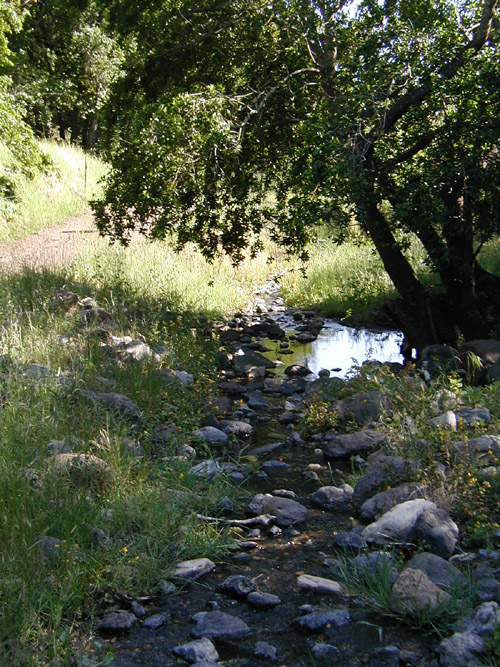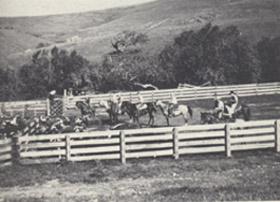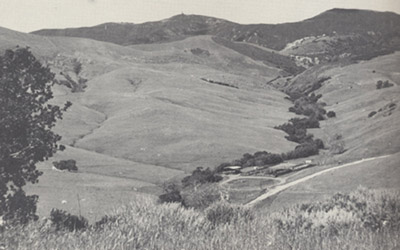|
Escuela/Walters
Ranches
|
|
Pennington Creek which runs throughout Escuela Ranch |
| The
Escuela and Walters Ranches are located approximately 8 miles North
of the Cal Poly campus on the East side of Highway 1. The ranches
consist of 2,562 acres of native rangeland. Escuela and Walters
Ranches were acquired by Cal Poly in different land parcels.
Escuela Ranch (Spanish for "school") was the first parcel of land obtained by Cal Poly. It is approximately 1,819 acres. When it was first acquired by Cal Poly in 1968, Escuela Ranch was essentially open rangeland. It was quickly improved by the Cal Poly Foundation with the addition of ranch facilities that were installed between 1969 and 1978. These facilities included a cattle working corral complex, a livestock scale, a classroom, equipment and feed storage sheds. Escuela Ranch is still used every year for a Commercial Cow/Calf Student Enterprise Project. It provides vital land for students to experience hands-on learning.
A student enterprise cattle roundup at Escuela Ranch in 1962. Cal Poly acquired the second and final parcel of land in January 1982, with the addition of 743 acres. This land was named "Walters Ranch" after a prominent County family of Charles Walter. So far, the sole use of this land has been for cattle grazing. The ranch is used for forage for the Escuela Cow/Calf Enterprise project, as well as for other Foundation beef cattle. For the past ten years, the Walters Ranch has been a control site for the Paired Watershed Study to research the effects of different grazing management techniques on the Morro Bay Estuary. Now that the study is concluded, Cal Poly has been awarded two grants to enhance water quality and environmental sustainability on Cal Poly land. One of the grants comes from the California Fish and Game department and the other is from the Morro Bay National Estuary Program. This grant was provided so that Cal Poly could make corrections and assure that the water flowing off of the ranches into Morro Bay is clean and not contaminated. In addition to water quality advancements, the Agriculture Departments main goal with the use of these grants is to develop an intensive grazing operation. This is a management operation in which the cattle are exposed to small area pastures for a short period of time. Intensive grazing is meant to prevent overgrazing on land while still allowing the animal full benefit from the feed. This management style is thought to be the most environmental way to graze animals, in that it can benefit the land when used correctly, and also allow the producer to profit off of the animals. Intensive grazing is meant to provide healthier soil which in turn will prevent water runoff to Morro Bay as well as create cleaner water. A cow/calf enterprise project occurs year-round on the Escuela and Walters Ranches. This project is entirely run by students with a faculty advisor overseeing the operation. The Escuela Enterprise allows students the opportunity to gain experience managing a commercial cattle operation for an entire production cycle. Students begin by developing a budget and then must make management decisions in relation to feeding, breeding, marketing, and range management in accordance with the budget. During the extent of this project, the cows and heifers are bred by artificial insemination. The females then go through gestation and calve approximately nine months later. The calves and their mothers are free grazed on pasture. The students on this project are in charge of making sure there are no calving difficulties among the animals and that the calves remain healthy. Once the calves reach an adequate weight, they are weaned from their mothers. The calves are then kept or sold to another rancher who will feed the calves while they grow further. The Escuela Enterprise is the culminating enterprise of a student's participation in the Beef Program and is reserved for juniors and seniors. For more information on this project, please visit the Cal Poly Animal Science web site: www.asci.calpoly.edu Escuela Ranch is also home to the Pennington Creek 200 acre Biological Preserve. This is a preserve utilized by the Biological Sciences Department. It provides students with the opportunity near campus to study plants, insects, wildlife and soil without the disruption of cattle and other intense animals. This site has also been the source of many senior projects by biology students. There have been senior projects done on the distribution of rare and endangered plants, the plant communities of Escuela Ranch, and the birds of Escuela Ranch. For more information on this valuable preserve, please visit the Biological Sciences Website by clicking here.
A view of Escuela Ranch in 1978. |
| Home
Click here to view more pictures of Escuela and Walters Ranches *Above history gathered from "An Illustrated History of Land Aquisition and Development for Agriculture Education," by John V. Stechman. 1985. |



